Simple Summary
The endangered fish Rhinogobio ventralis is highly susceptible to “white spot disease” caused by Ichthyophthirius multifiliis, making artificial cultivation challenging. Although studies have shown that adding salt can help control such parasites, its effects on the aquatic environment and the fish intestinal microbiota remain unclear. This study evaluated the effects of low-concentration salt (5‰) in freshwater aquaculture by monitoring water quality and microbial communities in both the aquatic environment and the fish intestine. The results showed that while salt treatment effectively suppressed harmful organisms such as I. multifiliis and Saprolegnia in the water, it also induced a series of negative effects. The self-purification capacity of the water declined, manifested as significant increases in dissolved oxygen and nitrogen levels, and the balance of the fish intestinal microbiota was disrupted, characterized by a significant increase in microbial diversity, enrichment of potentially pathogenic bacteria (e.g., Staphylococcus and Pseudomonas), and a decrease in the relative abundance of the beneficial bacterium Exiguobacterium. Our findings reveal that employing salinity for parasite control compromises the self-purification capacity of aquatic systems and disrupts intestinal microbial community stability. We therefore propose integrating salinity management with probiotic supplementation to establish truly sustainable aquaculture systems.
Abstract
The endangered Rhinogobio ventralis, endemic to the upper Yangtze River, is dependent on captive breeding for its conservation. However, this highly stress-sensitive species is exceptionally susceptible to Ichthyophthirius multifiliis, leading to severe pathology and high mortality in culture. Elevated salinity holds potential for managing key aquaculture pathogens, including Ichthyophthirius multifiliis and Saprolegnia spp. However, its potential unintended ecological consequences remain insufficiently understood. This study evaluated the systemic impacts of 5‰ salinity on the culture environment of the endangered species Rhinogobio ventralis, using integrated 16S/18S rRNA gene sequencing and water quality analysis. The results demonstrated that while salinity treatment effectively reduced the environmental molecular signal of harmful eukaryotes such as Ichthyophthirius and Saprolegnia, it also induced significant ecological shifts: (1) aquatic prokaryotic diversity increased, yet the self-purification capacity of the water was compromised, indicated by elevated dissolved oxygen, nitrate nitrogen, and total nitrogen; (2) in the fish intestinal microbiome, a decline in potentially beneficial taxa (e.g., Exiguobacterium) co-occurred with an enrichment of genera containing potentially pathogenic species (e.g., Staphylococcus and Pseudomonas), collectively suggesting a state of dysbiosis; (3) co-occurrence network analysis revealed that the aquatic microbial community developed greater complexity, while the intestinal network became structurally simplified and more antagonistic. These findings reveal that elevating salinity in freshwater aquaculture systems compromises both host microbiome health and aquatic ecosystem functioning. As such, future aquaculture management should integrate supportive measures like probiotic supplementation to maintain overall system stability.
1. Introduction
Rhinogobio ventralis, a species belonging to the order Cypriniformes, family Cyprinidae, and subfamily Gobioninae, is an endemic fish in the upper reaches of the Yangtze River in China. Valued for its nutritional quality and economic importance []. However, its natural populations are critically endangered, having been classified as “Endangered” in the China Red List of Vertebrates in 2016 [] and listed as a National Grade II Protected Wildlife Species in 2021. Artificial breeding is crucial for its conservation. However, this species is highly stress-sensitive and susceptible to disease in culture, especially Ichthyophthirius multifiliis. A recent study of R. ventralis demonstrated that I. multifiliis infection causes severe skin pathology, immune dysregulation, and metabolic disruption, underlying the high mortality rates []. However, no effective treatment is currently available [,]. Frequent outbreaks of I. multifiliis infections necessitate energy-intensive closed recirculating aquaculture systems (RAS) with high filtration and disinfection requirements, significantly impeding large-scale breeding efforts. Therefore, developing energy-efficient methods to control I. multifiliis is essential for conserving R. ventralis germplasm resources.
Studies indicate that elevated water salinity effectively mitigates I. multifiliis infections in fish. Ward [] demonstrated that Gila robusta cohabitated with I. multifiliis-infected Agosia chrysogaster in 3‰ salinity water remained healthy, while all individuals in freshwater died within 8 days. In vitro experiments demonstrated that salinities above 5‰ inhibit the development and hatching of the parasite’s infective stages []. The growth of the oomycete S. parasitica is also inhibited by increased salinity [], reinforcing the broad inhibitory role of salt against aquatic pathogens. Additionally, studies confirm the safety of moderate salinity in freshwater aquaculture. Bal et al. [] reported no notable alterations in specific growth rate, hematological parameters, or feeding behavior in Heteropneustes fossilis reared at 3‰ salinity for 45 days. Furthermore, Jia et al. [] confirmed that grass carp (Ctenopharyngodon idella) maintained normal growth performance under 5‰ salinity during a continuous 42-day exposure. These findings collectively indicate that controlled salinity strategies are associated with a reduction in I. multifiliis infection signals while generally causing no significant physiological harm to fish, suggesting this approach holds promise as a foundation for energy-efficient solutions for I. multifiliis management in R. ventralis aquaculture. However, the ecological cost of elevated salinity for host-associated microbial communities remains unassessed.
As a critical environmental filter and osmotic stressor, salinity exerts a profound influence on microbial communities []. It restructures microbial communities and their metabolic functions in the water [,]. Salinity also indirectly shapes the intestinal microbiota of fish by altering both the environmental microbial pool and host-derived nutrient niches [,]. Consequently, the evaluation of any salinity intervention must account for its broad, systemic consequences rather than a narrow focus on a single pathogen. Despite its use in aquaculture, a holistic understanding of how salinity shapes the microbial ecology of both the water and the host intestine in conservation-oriented systems is lacking.
This study investigates how 5‰ salinity affects the aquatic microbiota, intestinal microbial ecosystem, and eukaryotic communities of the endangered R. ventralis. We focus specifically on its under-explored consequences for host-microbe homeostasis and overall microecological balance. Using integrated 16S/18S rRNA sequencing and water quality analysis, we aimed to (1) characterize structural and compositional shifts in both the aquatic microbiota and fish intestinal microbiota under 5‰ salinity exposure; (2) compare salinity-driven changes in microbial interaction networks between the aquatic environment and the host intestine; and (3) evaluate the ecological safety of using elevated salinity to control aquatic eukaryotic pathogens in conservation-oriented aquaculture.
2. Materials and Methods
2.1. Ethical Statement
All animal procedures in this research were conducted in accordance with the Guidelines for the Care and Use of Laboratory Animals in China and approved by the Southwest University Animal Ethics Committee (permit No. IACUC-20230928-01).
2.2. Experimental Design and Salinity Treatment
We cultured R. ventralis sourced from a farm in Jingzhou, Hubei Province, in a high-sterilization, high-filtration recirculating aquaculture system (RAS) at the Integrative Science Center of Germplasm Creation in Western China (Chongqing, China) Science City (Figure A1). The culture tanks measured 0.8 m in diameter and 1.0 m in height, with a stocking density set at 50 fish per tank. Two weeks after culture initiation, the fish (average body length 5.14 ± 0.58 cm, average body weight 2.26 ± 0.19 g) exhibited visible signs, including a low density of white spots on the body surface (Figure 1a). Based on these characteristic signs, the condition was tentatively diagnosed as Ichthyophthiriasis []. Critically, skin histopathological examination (H&E staining, ×40) was performed on a representative individual to confirm the presence of I. multifiliis trophonts in the epidermal layer (Figure 1b). Since increasing water salinity to 5‰ is widely utilized in aquaculture to inhibit the free-living stages of aquatic eukaryotes, understanding its broader ecological consequences is crucial. Therefore, this preliminary study was designed to evaluate the ecological implications and potential trade-offs of salinity application at 5‰ by assessing its impact on the water prokaryotic/eukaryotic molecular communities and host intestinal microbial communities in R. ventralis. We employed an experimental intervention by increasing the water salinity to 5‰ and conducted a 30-day monitoring assay to observe the capacity of salinity to reduce the environmental molecular signal of I. multifiliis in the freshwater system. Our integrated assessment simultaneously monitored the water microbial and eukaryotic communities (16S and 18S rRNA), the fish intestinal microbiome (16S rRNA), and key water quality parameters. The baseline for this intervention was set as the day before salinity application commenced (Day 0). The experimental design and sampling timeline are illustrated in Figure 2.
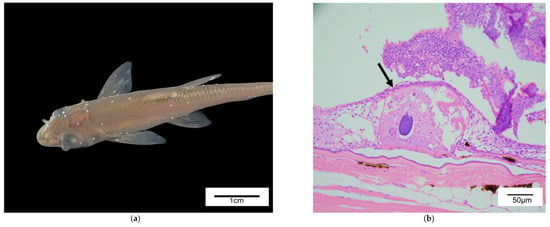
Figure 1.
Morphological and histopathological characterization of R. ventralis with external symptoms: (a) External view of a representative fish exhibiting white spots on the body surface. (b) Skin histology (H&E staining, 40×) of the individual in (a), showing trophonts consistent with I. multifiliis in the epidermal layer (indicated by black arrows).
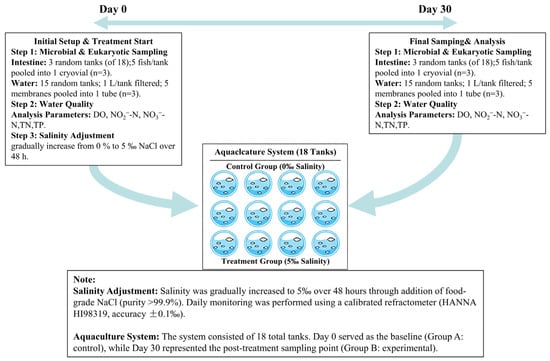
Figure 2.
The schematic of the experiment design and timeline.
During the trial, water salinity in treatment groups was maintained at 5.0 ± 0.3‰ using a portable salinity meter (HANNA HI98319; ±0.1‰ accuracy) by supplementing aerated tap water or NaCl solution (5‰). All tanks maintained a temperature of 22.0 ± 0.5 °C. Fish were fed commercial feed (3% of total biomass) twice daily at 09:00 and 17:00.
2.3. Sampling Protocols
2.3.1. Intestinal Microbial Sampling
Sampling was conducted on Day 0 (pre-experiment) and Day 30 (after treatment with 5‰ salinity). Three tanks were randomly selected from 18 aquaculture tanks using a random number table. Five R. ventralis individuals were collected per selected tank, and their intestinal contents were aseptically dissected. Contents from five fish within the same tank were pooled into a sterile cryovial (1 vial/tank; 3 vials total), flash-frozen in liquid nitrogen, and stored at −80 °C for 16S rRNA sequencing.
2.3.2. Water Microbial and Eukaryotic Community Sampling
Sampling was conducted on Day 0 and Day 30. Fifteen tanks were randomly selected, and 1 L of water was collected from each using sterile glass bottles. Each liter was vacuum-filtered through a 0.45 μm cellulose acetate membrane (Millipore, Burlington, MA, USA), yielding 15 membranes. Five membranes were randomly pooled into one 50 mL centrifuge tube (3 tubes total) and stored at −80 °C for 16S and 18S rRNA sequencing. The 18S rRNA sequencing data were used to quantify the relative abundance of I. multifiliis within the aquatic environment’s eukaryotic community, representing the circulating parasite load in the system. This approach provides a measure of molecular signal based on sequence proportions, which is not equivalent to classical parasitological metrics (e.g., mean abundance, prevalence, or intensity) proposed by Bush et al. []. Consequently, this molecular data should be interpreted solely as a description of changes in the environmental microbial composition.
2.3.3. Water Quality Analysis
On Day 0 and Day 30, water samples were collected from three randomly selected tanks. On-site measurements of pH were taken using a portable pH meter (HANNA HI9811-5, Woonsocket, RI, USA; ±0.01 accuracy). Concentrations of dissolved oxygen (DO), nitrite nitrogen (NO2−-N), nitrate nitrogen (NO3−-N), total nitrogen (TN), and total phosphorus (TP) were measured within 24 h using a SEAL AA3 AutoAnalyzer (Merck KGaA, Darmstadt, Germany), following the Standard Methods for the Examination of Water and Wastewater (APHA, 23rd edition) [].
2.4. Bacterial 16S rRNA Target Amplification and PCR Purification
Genomic DNA was extracted using the TIANGEN Genomic DNA Kit (TIANGEN, Beijing, China) and quantified via NanoDrop 2000 spectrophotometer (Thermo Fisher Scientific, Waltham, MA, USA). The V3-V4 region of bacterial 16S rRNA was amplified with primers 338F (5′-ACTCCTACGGGAGGCAGCAG-3′) and 806R (5′-GGACTACHVGGGTWTCTAAT-3′). PCR reactions (20 μL total) included 10 μL 2× Pro Taq DNA Polymerase Mix (Accurate Biotechnology, Changsha, China), 1 μL template DNA (10 ng/μL), 0.8 μL each primer (5 μM), and ddH2O. Cycling conditions: 95 °C for 3 min; 29 cycles of 95 °C/30 s, 53 °C/30 s, 72 °C/45 s; final extension at 72 °C/10 min. Amplicons were electrophoresed on 2% agarose gels (GelRed, Biotium, Fremont, CA, USA), purified using an Axygen Gel Extraction Kit (Axygen, Union City, CA, USA), and sequenced on Illumina NovaSeq 6000 (PE250 mode) by Majorbio Co., Ltd. (Shanghai, China).
2.5. Eukaryotic 18S rRNA Target Amplification and PCR Purification
The V9 region of eukaryotic 18S rRNA was amplified with primers Euk1391F (5′-GTACACACCGCCCGTC-3′) and EukBR (5′-TGATCCTTCTGCAGGTTCACCTAC-3′). Reaction conditions mirrored Section 2.4. Purified products were sequenced as above.
2.6. Data Processing
Microbial community analysis was performed using high-throughput sequencing on an Illumina NovaSeq 6000 platform (PE250 mode). Water microbiota were characterized via amplicon sequencing targeting the 16S rRNA gene (V3-V4 region, primers 338F/806R) and the 18S rRNA gene (V9 region, primers Euk1391F/EukBR), while intestinal microbiota were assessed using 16S rRNA gene sequencing. Raw sequences underwent quality control using Fastp (v0.23.2) [], followed by denoising and generation of amplicon sequence variants (ASVs) with DADA2 (v1.26.0) []. ASVs were subsequently clustered into operational taxonomic units (OTUs) at 97% similarity. This approach was employed to facilitate direct comparison with foundational literature and established databases that utilize an OTU-based framework. Taxonomic classification of bacterial sequences utilized the SILVA database (v138), and eukaryotic sequences were classified using the PR2 database (v5.0). The relative abundance of I. multifiliis was determined by the proportion of its assigned 18S rRNA sequences within the total eukaryotic reads for each water sample. α-Diversity indices (Shannon, Simpson, ACE, Chao1) and β-diversity analysis (principal coordinates analysis (PCoA) based on Bray–Curtis dissimilarity) were conducted in QIIME2 (v2022.2) []. Significant differences in community composition were assessed using PERMANOVA (Adonis algorithm, 999 permutations) and ANOSIM; biomarker taxa were identified via LEfSe analysis (LDA score > 4, p < 0.05). Associations between microbial communities and environmental factors were evaluated using redundancy analysis (RDA) and Mantel tests (Pearson correlation, 999 permutations). Microbial co-occurrence networks were constructed based on SparCC correlations (|ρ| > 0.6, p < 0.01). This algorithm was specifically chosen because it is designed to infer true correlation structures within compositional data, such as microbial relative abundances, thereby avoiding the spurious correlations that can arise from standard methods like Spearman or Pearson correlation. Node topological properties were visualized in Gephi (v0.10.1).
3. Results
3.1. Water Microbial and Eukaryotic Molecular Signal Dynamics
3.1.1. Microbial and Eukaryotic Diversity Response to Salinity
After normalization, 358,978 prokaryotic and 607,235 eukaryotic high-quality sequences were retained (Coverage > 0.99; Table 1). For prokaryotes (Figure 3a), 5‰ salinity (Group B) significantly increased Shannon diversity (p < 0.05), indicating increased diversity, but did not alter ACE or Chao1 indices (p > 0.05). Eukaryotes exhibited reduced ACE, Chao1, and Shannon indices (p < 0.05) and an elevated Simpson index (p < 0.05), indicating suppressed richness and diversity under salinity application. Venn analysis (Figure 3b) revealed 1167 eukaryotic OTUs (Group A: 564 unique; Group B: 201 unique; shared: 402). Prokaryotic ASVs totaled 3079 (Group A: 1273 unique; Group B: 1643 unique; shared: 163 [5.29%]). UPGMA clustering (Figure 3c,d) showed high similarity within salinity groups (A1–A3; B1–B3), confirming salinity as a key driver of community divergence.

Table 1.
Summary of high-throughput sequencing data (reads, OTUs, ASVs, coverage).
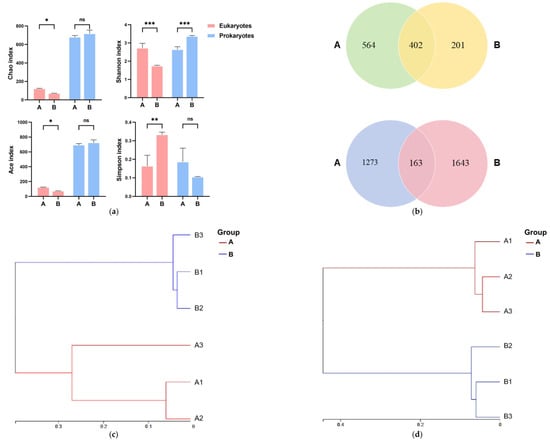
Figure 3.
(a) Prokaryotic/eukaryotic α-diversity indices. (b) Venn diagram: prokaryotic (top)/eukaryotic (bottom) in water. (c) OTU-level clustering. (d) ASV-level clustering. Note: Statistical significance is indicated as follows: ns, not significant (p > 0.05); *, p < 0.05; **, p < 0.01; ***, p < 0.001.
3.1.2. Compositional Shifts in Water Microbial and Eukaryotic Communities
For eukaryotes, dominant phyla (relative abundance ≥ 1%) shared between groups at the phylum level (Figure 4a) included Ciliophora, Euglenozoa, Rotifera, and Gastrotricha. At the genus level (Figure 4b), shared dominant genera (≥1%) were Ichthyophthirius, Amphileptus, and Saprolegnia. For prokaryotes, dominant phyla (Figure 4c) across both groups were Proteobacteria, Bacteroidota, and Firmicutes, while shared dominant genera (≥1%) included Solitalea, Sediminibacterium, Novosphingobium, and Hydrogenophaga (Figure 4d).
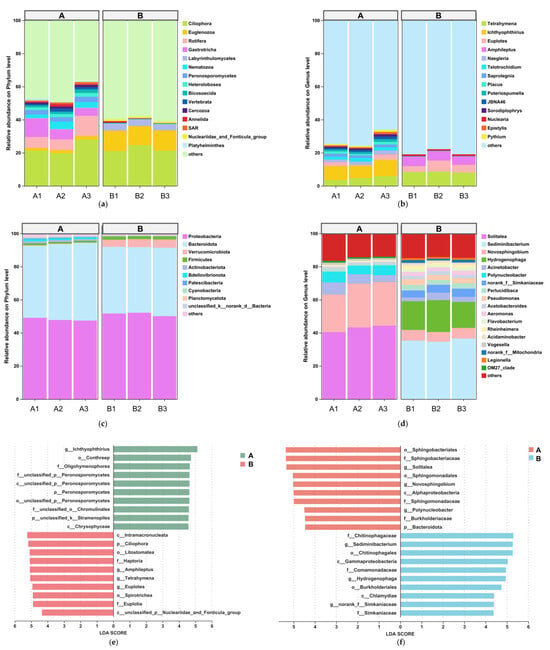
Figure 4.
Microbial composition and biomarkers in water: (a) Eukaryotic phylum level. (b) Eukaryotic genus level. (c) Prokaryotic phylum level. (d) Prokaryotic genus level. (e) LEfSe: eukaryotic biomarkers (LDA > 4). (f) LEfSe: prokaryotic biomarkers (LDA > 4).
LEfSe analysis (LDA score > 4; Figure 4e,f) revealed taxonomic differences between groups. In eukaryotes, Group A exhibited significant enrichment of Ichthyophthirius, whereas Group B showed higher abundances of Amphileptus and Euglenozoa. For prokaryotes, salinity treatment significantly reduced the relative abundance of Solitalea, Novosphingobium, Bacteroidota, Polynucleobacter, Sphingobacteriales, and Alphaproteobacteria. Conversely, taxa such as Sediminibacterium, Hydrogenophaga, Simkaniaceae, and Comamonadaceae, among others, were markedly enriched under elevated salinity. All reported differences were statistically significant (p < 0.05).
Results revealed a marked reduction in the molecular signal of key eukaryotic taxa in the aquaculture water following salinity application (Figure 5). The relative abundance of Ichthyophthirius, the causative agent of white spot disease, decreased from an average of 8.58% in the pre-treatment group (Group A) to undetectable levels in the post-treatment group (Group B) (p < 0.01). Similarly, the relative abundance of the oomycete Saprolegnia declined from an average of 1.65% in Group A to undetectable levels in Group B (p < 0.01).
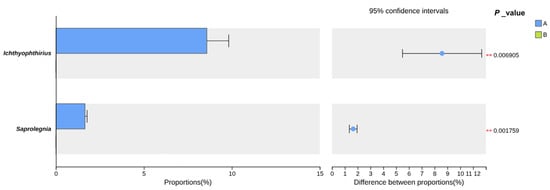
Figure 5.
Relative Abundance of Ichthyophthirius and Saprolegnia before and after 5‰ salinity application. Note: ** indicates a highly significant difference (p < 0.01).
3.1.3. Effects of Salinity on Water Physicochemical Parameters
Water quality parameters in the aquaculture system were analyzed (Figure 6a). Dissolved oxygen (DO), nitrate–nitrogen (NO3−-N), and total nitrogen (TN) concentrations were significantly higher in Group B than in Group A. Redundancy analysis (RDA) identified key environmental drivers of microbial community variation. RDA1 and RDA2 explained 99.49% and 0.30% of the variance in the top 10 genera, respectively (Figure 6b). NO3−-N, TN, total phosphorus (TP), and DO significantly influenced microbial community composition (p < 0.05). RDA1 was primarily driven by NO3−-N, TN, TP, and DO, with Group A samples negatively correlated and Group B samples positively correlated with RDA1.

Figure 6.
(a) Water quality parameters (DO, NO3−-N, TN, and TP) across salinity gradients. (b) RDA ordination plot showing physicochemical drivers of microbial communities. Note: Statistical significance is indicated as follows: ns, not significant (p > 0.05); **, p < 0.01; ****, p <0.0001.
3.2. Compositional Shifts in Intestinal Microbial Communities
At the phylum level (Figure 7a), the top 10 dominant phyla (relative abundance ≥1%) shared between groups included Proteobacteria, Firmicutes, Actinobacteriota, and Bacteroidota. At the genus level (Figure 7b), shared dominant genera (≥1%) among the top 10 taxa were Aeromonas, Acinetobacter, Pelomonas, and Acidovorax. LEfSe analysis (LDA score > 4; Figure 7c) revealed differential taxa from phylum to genus levels: Exiguobacterales, Exiguobacterium, and Exiguobacteraceae were significantly enriched in Group A, while Pseudomonadales, Alphaproteobacteria, Acinetobacter, Moraxellaceae, Rhizobiales, Hyphomicrobiaceae, Hyphomicrobium, Staphylococcus, Cloacibacterium, Weeksellaceae, Bacteroidia, Bacteroidota, and Pedomicrobium were enriched in Group B.

Figure 7.
Intestinal microbiota dynamics: (a) Phylum composition. (b) Genus composition. (c) LEfSe biomarkers (LDA > 4).
3.3. Water–Intestinal Microbial Interaction Networks
3.3.1. Community Association Patterns
Under 5‰ salinity treatment, increased Shannon index and decreased Simpson index (p < 0.05) in intestinal microbiota indicated enhanced species richness and evenness of intestinal microorganisms (Figure 8a). Significant spatial separation of communities confirmed by PCoA and ANOSIM (p = 0.001), combined with low water–intestinal shared OTU proportions (8.8–20.1%; 117/1645 vs. 128/2307) (Figure 8b,c), suggested that salinity influenced the structural characteristics of the intestinal microbial community. Although elevated salinity increased water OTU numbers, ACE/Chao indices consistently showed significantly higher microbial diversity in water than intestines (p < 0.05) without significant inter-group fluctuations, indicating greater stability of water microbiota against environmental disturbance compared to host-associated microbial communities.
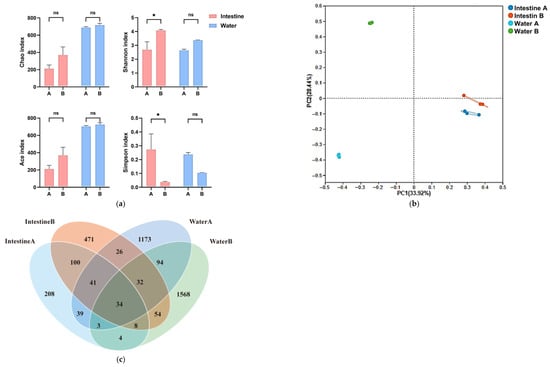
Figure 8.
Cross-domain microbial interactions: (a) α-Diversity (water vs. intestinal). (b) PCoA ordination of water and intestinal communities. (c) Shared/unique OTUs between water and intestinal ecosystems. Note: Statistical significance is indicated as follows: ns, not significant (p > 0.05); *, p < 0.05.
3.3.2. Key Species Interactions in Water and Intestinal Microbiota
Elevated salinity conditions induced divergent structural responses in the microbial co-occurrence networks of the intestine and aquatic environments (Figure 9). In the intestine, the network simplified, with a reduction in total edges (61 to 54) and a corresponding decrease in average degree (6.42 to 5.68), indicating lower connectivity (Figure 9c,d; Table 2). This was accompanied by a fundamental shift from a cooperative to a competitive dynamic, as the positive-to-negative edge ratio inverted from 1.90 to 0.93 (Table 2). This structural shift was marked by a succession of keystone phyla, where the control group’s core module, including Firmicutes, was replaced by a new module led by extremophiles like Deinococcota under elevated salinity conditions.
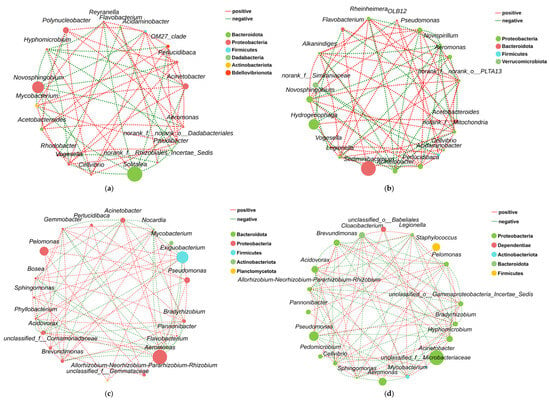
Figure 9.
Microbial co-occurrence networks (Spearman’s |ρ| > 0.6, p < 0.05): (a) Water control group. (b) Water 5‰ salinity group. (c) Intestinal control group. (d) Intestinal 5‰ salinity group. Note: The size of each node corresponds to its degree (the number of connections with other nodes). The edges indicate the relationships between genera, with red lines representing positive connections and green lines representing negative connections.

Table 2.
Topological properties of microbial co-occurrence networks in the intestine and water microbiota under control and salinity application.
Conversely, the aquatic network became more complex and cooperative, with an increase in total edges (56 to 66) and average degree (5.89 to 6.60) (Figure 9a,b; Table 2). Cooperative interactions were strengthened, evidenced by an increased positive-to-negative edge ratio from 1.55 to 2.00 (Table 2). Here, the keystone genus shifted from a Solitalea-led module to a larger, more interconnected module headed by the highly adaptive Pseudomonas.
4. Discussion
4.1. Structural Impact of 5‰ Salinity on Environmental and Host Microbiomes
Our results reveal that salinity acts as a potent environmental filter, driving divergent and distinct structural changes in the aquatic and intestinal microbial communities.
4.1.1. Aquatic Ecological Response
Salinity acts as a powerful environmental filter, driving divergent responses between prokaryotic and eukaryotic communities in the aquaculture water. Our results showed that 5‰ salinity significantly increased prokaryotic Shannon diversity, while concurrently reducing eukaryotic richness and diversity. This suggests that low salinity selected for halotolerant bacteria, allowing them to occupy newly available niches [,] while simultaneously suppressing osmosensitive eukaryotes []. This restructuring was evident at the community level, where co-occurrence network analysis revealed a significant increase in complexity, connectivity, and cooperative interactions in the salinity-treated group (Table 2). This structural reinforcement indicates an adaptive response, where the prokaryotic community formed new synergistic relationships to create a more stable and resilient ecosystem under osmotic stress []. The succession of the keystone genus from Solitalea to the highly adaptive Pseudomonas further underscores a functional reorganization toward taxa better suited for the modified environment [].
The application of salinity significantly reduced the molecular signal of I. multifiliis and Saprolegnia spp. in the water (Figure 5), which is consistent with the documented effect of salinity on these pathogens in freshwater systems. Specifically, salinity levels > 3‰ inhibit I. multifiliis tomont hatching [], and levels > 1‰ not only inhibit Saprolegnia hyphal extension osmotically [] but also directly impair the pathogenicity of Saprolegnia parasitica by suppressing mycelial growth, zoospore release, and protease activity [].
4.1.2. Water Quality Changes and Impairment of Biogeochemical Function
LEfSe analysis revealed a significant reduction in the abundance of Solitalea, an important autotrophic denitrifier [], while taxa with denitrifying capabilities like Hydrogenophaga and the new keystone genus Pseudomonas were enriched []. This indicates a functional replacement within the nitrogen-cycling guild. However, the observed increases in total nitrogen (TN) and nitrate–nitrogen (NO3−-N) in the water column suggest that this new consortium was less efficient at nitrogen removal than the original community under the closed-system conditions of this study. The suppression of key functional taxa like Solitalea appears to have created a bottleneck in the denitrification process, leading to nutrient accumulation. This demonstrates that even when a microbial community adapts structurally, critical ecosystem functions like nutrient remediation can be impaired.
4.2. Salinity Impacts on Intestinal Microbial Consortia
4.2.1. Salinity-Driven Modulation of Intestinal Microbial Diversity
Salinity elevation induces significant restructuring of fish intestinal microbial diversity and functional profiles. Our study revealed that 5‰ salinity substantially enhanced alpha diversity and operational taxonomic unit (OTU) richness in the intestinal microbiota of R. ventralis. This aligns with observations in Pangasianodon hypophthalmus juveniles exhibiting maximal alpha diversity under 5‰ salinity []. In stark contrast to the adaptive response observed in the water, salinity stress destabilized the intestinal microbiome. While α-diversity metrics like the Shannon index increased, this was not indicative of a healthier community. Instead, co-occurrence network analysis revealed a significant simplification of the intestinal network, with fewer connections and a fundamental shift from cooperative to antagonistic interactions (Table 2). A loss of network stability and a rise in negative correlations are hallmarks of a disturbed and dysbiotic microbial community [], which is a key indicator of compromised host health and an associated risk factor for increased susceptibility to secondary infections and disease in aquaculture [,]. This dysbiosis was characterized by a major shift in core phyla, where the keystone module led by Firmicutes was displaced by one dominated by extremophilic phyla like Deinococcota. This suggests that the increase in species richness was likely due to the breakdown of the stable, resident community, allowing transient or opportunistic taxa to colonize, rather than an enhancement of ecosystem function.
4.2.2. Enrichment of Potentially Opportunistic Taxa in the Intestinal Microbiota
Salinity-associated shifts in the intestinal microbiota of R. ventralis revealed significant enrichment of opportunistic pathogens under 5‰ salinity, including Staphylococcus, Bacteroidota, Moraxellaceae, Weeksellaceae, Acinetobacter, and Pseudomonadales. Staphylococcus members produce enterotoxins implicated in mortality events in tilapia and mink [,]. Moraxellaceae encompasses facultative pathogens associated with visceral colonization, metabolic dysregulation, growth retardation, and immunosuppression in fish []. Bacteroidota-derived lipopolysaccharides (LPSs) induce inflammatory responses and intestinal barrier dysfunction [], while Weeksellaceae exacerbates intestinal inflammation and disrupts villus morphogenesis []. Acinetobacter species, notably A. junii, provoke intestinal pathologies [,], and Pseudomonas members are established etiological agents of hemorrhagic septicemia, ulceration, ascites, and hepatic lesions in fish []. This increase in potentially opportunistic microorganisms reflects a significant structural shift in the intestinal microbiota.
4.2.3. Impact of Salinity on Potential Beneficial Taxa
The 5‰ salinity treatment resulted in a significant reduction in Exiguobacterium abundance within the intestinal microbiota of cultured fish. As a potential probiotic genus, Exiguobacterium members synthesize amylases, lipases, and proteases to enhance decomposition of complex nutrients in feedstuffs, while fermenting carbohydrates to produce short-chain fatty acids (SCFAs) like propionate and butyrate, thereby improving nutrient absorption efficiency and reinforcing intestinal epithelial barrier function []. This genus may further inhibit pathogen proliferation through nutrient competition or antimicrobial compound secretion []. The salinity-induced reduction in probiotic abundance suggests that interventions such as probiotic supplementation warrant further investigation to maintain intestinal homeostasis when modulating the aquatic environment with salinity.
4.2.4. Salinity-Driven Aquatic-Intestinal Microbial Cross-Domain Interactions
The opposing responses of the intestinal and water microbial networks to salinity stress highlight fundamentally different ecological strategies in host-constrained versus open environments. The simplification and shift to antagonism in the intestinal network are characteristic of dysbiosis, where environmental stress destabilizes the community by intensifying internal competition for resources, ultimately compromising host health []. The emergence of Deinococcota, a phylum known for extreme stress resistance [], signifies an adaptive response at the microbial level but likely at the expense of beneficial host-symbiont functions []. In contrast, the aquatic microbial community adapted by enhancing network complexity and cooperation. This structural reinforcement suggests an adaptive strategy where microbes form new synergistic relationships to collectively overcome the environmental challenge, leading to a more resilient and stable ecosystem []. The succession to a Pseudomonas-dominated core reflects a functional reorganization toward genera better equipped to thrive under saline conditions []. For aquaculture, these findings underscore a critical duality: while the external environment’s microbiota may adapt robustly, the same stressor can destabilize the internal microbiome crucial for fish health, necessitating management strategies that consider both ecosystems [].
Overall, this preliminary assessment reveals a key ecological trade-off: the significant reduction in the environmental molecular signal of I. multifiliis and Saprolegnia spp., at 5‰ salinity, coincided with marked destabilization of the intestinal microecology. In this context, supplementation with probiotic genera, such as Bacillus and Lactobacillus, represents a promising avenue for future research [,]. These probiotics are known to improve intestinal health by competitively excluding opportunistic pathogens, producing antimicrobial compounds, and modulating host immunity, mechanisms that could potentially help restore microbial balance and enhance disease resistance in fish [].
5. Conclusions
While the application of 5‰ salinity successfully reduced the molecular signal of key pathogens (I. multifiliis and Saprolegnia spp.) in the water, this study reveals that this reduction in pathogen molecular signals is accompanied by previously overlooked costs to host health and ecosystem function. The treatment induced a systemic restructuring of microbial communities, characterized by several critical shifts:
- (1)
- In the aquatic environment, increased prokaryotic diversity and network complexity coincided with impaired self-purification capacity, evidenced by elevated dissolved oxygen, nitrate nitrogen, and total nitrogen.
- (2)
- In the host, the intestinal microbiome underwent significant destabilization; this was characterized by a simplification of its interaction network, a surge in potentially opportunistic taxa, and a decline in potential beneficial probiotics, all collectively indicating a state of dysbiosis.
- (3)
- A fundamental divergence in microbial adaptation strategies was observed: the environmental community enhanced its resilience through increased cooperation, whereas the host-associated intestinal community shifted toward a stressed, antagonistic state.
These findings underscore a critical ecological trade-off: the established practice of using salinity for pathogen control achieves its goal at the direct expense of host microbiome integrity and aquatic ecosystem functioning. Therefore, moving forward, aquaculture management must look beyond merely suppressing waterborne pathogens and adopt an integrated perspective that equally prioritizes host internal health and the stability of the water microbiome. Future strategies should explore combining salinity application with microbiome-supporting interventions, such as targeted probiotic supplementation, to mitigate these adverse effects and foster a more sustainable, health-oriented aquaculture system.
Author Contributions
Conceptualization, K.L. and F.L.; Data curation, K.L. and T.J.; Formal analysis, K.L. and T.J.; Funding acquisition, F.L.; Investigation, K.L., Q.Z., T.J., X.L., H.S., X.W. and H.G.; Methodology, K.L.; Project administration, F.L.; Resources, H.S. and H.G.; Software, Q.Z., X.L. and H.G.; Supervision, Q.Z. and H.S.; Validation, X.L. and X.W.; Visualization, K.L.; Writing—original draft, K.L.; Writing—review and editing, H.G. and F.L. All authors have read and agreed to the published version of the manuscript.
Funding
This research was supported by the National Natural Science Foundation of China (32202971), the Chongqing Fisheries Science and Technology Innovation Alliance (CQFTIU2024-08 and CQFTIU202501-4), and Major Science and Technology Research Project of Chongqing Municipal Education Commission (KJZD-M202401301).
Institutional Review Board Statement
The animal study protocol was approved by the Animal Ethics Committee of Southwest University (permit No. IACUC-20230928-01).
Informed Consent Statement
Not applicable. This study did not involve human participants. The fish used in the study were sourced from a commercial fish farm, and permission to use the animals was obtained from the farm owner.
Data Availability Statement
The original contributions presented in this study are included in the article. Further inquiries can be directed to the corresponding authors.
Acknowledgments
We would like to express our gratitude to Xiao Yang, Shilin Li, Li Peng, Rong Huang, He Gao, Yang Zhou, and other staff members of the Key Laboratory of Freshwater Fish Reproduction and Development for their assistance with the work.
Conflicts of Interest
Author Hailong Ge was employed by the company Postdoctoral Research Workstation of Chongqing Fengdu Agricultural Science and Technology Development Group Co., Ltd. The remaining authors declare that the research was conducted in the absence of any commercial or financial relationships that could be construed as a potential conflict of interest.
Abbreviations
The following abbreviations are used in this manuscript:
| R. ventralis | Rhinogobio ventralis |
| I. multifiliis | Ichthyophthirius multifiliis |
| RAS | Recirculating aquaculture system |
| OTUs | Operational taxonomic units |
| ASVs | Amplicon sequence variants |
| RDA | Redundancy analysis |
| PCoA | Principal co-ordinates analysis |
| DO | Dissolved oxygen |
| NO3−-N | Nitrate nitrogen |
| TN | Total nitrogen |
Appendix A
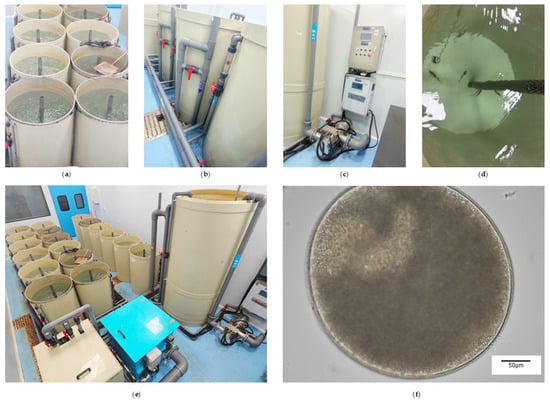
Figure A1.
(a) Top view of multiple culture tanks. (b) Detailed view of the tank side plumbing, including water inlet, return pipes, and drainage valves used for water quality management. (c) Close-up of the main control panel and filtration unit of the RAS, highlighting the plumbing for water circulation. (d) Top-down view of the tank interior, showing the central water column and water conditions. (e) Overall view of the high-sterilization, high-filtration recirculating aquaculture system (RAS) room. (f) Microscopic image of an isolated trophont of I. multifiliis, morphologically characterized after collection from water samples.
References
- Bao, X.; Xie, W.; Huang, D.; Zhu, B. Analysis of meat percentage and nutritional components of the long fin gill snail in the jinsha river. J. Hydroecol. 2011, 32, 142–148. [Google Scholar]
- Jiang, Z.G.; Jiang, J.P.; Wang, Y.Z. China’s Red List of Vertebrates: Volume 1—Vertebrate Overview; Report; Ministry of Environmental Protection & Chinese Academy of Sciences: Beijing, China, 2016. [Google Scholar]
- Zhao, Q.; Li, S.; Wang, S.; Zhao, Z.; Li, X.; Sun, H.; Wu, X.; Wang, Z.; Li, F. Response of rhinogobio ventralis skin to ichthyophthirius multifiliis infection: Pathological, transcriptomic and metabolomic analyses. Fish. Shellfish. Immunol. 2025, 167, 110679. [Google Scholar] [CrossRef]
- Zhu, Y.; Wu, X.; He, Y.; Yang, D. Study on broodstock culture, induced spawning and artificial incubation of Rhinogobio ventralis (sauvage et dabry) in recirculating aquaculture system. Freshw. Fish. 2018, 48, 101–106. [Google Scholar]
- Huang, K.; Wang, R.; Hu, G.; Zhou, W.; Li, W.; Zou, H.; Wang, G.; Li, M. Immune response of Rhinogobio ventralis to Ichthyophthirius multifiliis infection: Insights from histopathological and real-time gene expression analyses. Fish. Shellfish. Immunol. 2024, 153, 109801. [Google Scholar] [CrossRef]
- Ward, D.L. Salinity of the little colorado river in grand canyon confers anti-parasitic properties on a native fish. West. N. Am. Nat. 2012, 72, 334–338. [Google Scholar] [CrossRef]
- Aihua, L.; Buchmann, K. Temperature-and salinity-dependent development of a nordic strain of Ichthyophthirius multifiliis from rainbow trout. J. Appl. Ichthyol. 2001, 17, 273–276. [Google Scholar] [CrossRef]
- Sformo, T.L.; De la Bastide, P.Y.; LeBlanc, J.; Givens, G.H.; Adams, B.; Seigle, J.C.; Kunaknana, S.C.; Moulton, L.L.; Hintz, W.E. Temperature response and salt tolerance of the opportunistic pathogen saprolegnia parasitica: Implications for the broad whitefish subsistence fishery. Arct. Antarct. Alp. Res. 2021, 53, 271–285. [Google Scholar] [CrossRef]
- Bal, A.; Pati, S.G.; Panda, F.; Mohanty, L.; Paital, B. Low salinity induced challenges in the hardy fish Heteropneustes fossilis; Future prospective of aquaculture in near coastal zones. Aquaculture 2021, 543, 737007. [Google Scholar] [CrossRef]
- Jia, Y.; Du, J.; Xi, R.; Zhang, Q.; Li, L.; Li, D.; Takagi, Y.; Zhang, X. Effects of different culture salinities on the growth and muscle quality of grass carp (Ctenopharyngodon idellus). J. Anim. Sci. 2024, 102, skae281. [Google Scholar] [CrossRef]
- Zhang, K.; Shi, Y.; Cui, X.; Yue, P.; Li, K.; Liu, X.; Tripathi, B.M.; Chu, H. Salinity is a key determinant for soil microbial communities in a desert ecosystem. mSystems 2019, 4, 11. [Google Scholar] [CrossRef]
- Mkulo, E.M.; Iddrisu, L.; Yohana, M.A.; Zheng, A.; Zhong, J.; Jin, M.; Danso, F.; Wang, L.; Zhang, H.; Tang, B.; et al. Exploring salinity adaptation in teleost fish, focusing on omics perspectives on osmoregulation and gut microbiota. Front. Mar. Sci. 2025, 12, 1559871. [Google Scholar] [CrossRef]
- Li, X.; Wang, A.; Wan, W.; Luo, X.; Zheng, L.; He, G.; Huang, D.; Chen, W.; Huang, Q. High salinity inhibits soil bacterial community mediating nitrogen cycling. Appl. Environ. Microbiol. 2021, 87, e01366-21. [Google Scholar] [CrossRef] [PubMed]
- Kanika, N.H.; Liaqat, N.; Chen, H.; Ke, J.; Lu, G.; Wang, J.; Wang, C. Fish gut microbiome and its application in aquaculture and biological conservation. Front. Microbiol. 2025, 15, 1521048. [Google Scholar] [CrossRef]
- Floyd, R.F. Reed, Ichthyophthirius multifiliis (White Spot) Infections in Fish; Fisheries and Aquatic Sciences Department, Florida Cooperative Extension Service, Institute of Food and Agricultural Sciences, University of Florida: Gainesville, FL, USA, 2009; CIR 920. [Google Scholar]
- Bush, A.O.; Lafferty, K.D.; Lotz, J.M.; Shostak, A.W. Parasitology meets ecology on its own terms: Margolis et al. revisited. J. Parasitol. 1997, 83, 575–583. [Google Scholar] [CrossRef]
- APHA. Standard Methods for the Examination of Water and Wastewater, 23rd ed.; American Public Health Association: Washington, DC, USA, 2017; ISBN 978-0-87553-287-0. [Google Scholar]
- Chen, S.; Zhou, Y.; Chen, Y.; Gu, J. Fastp: An ultra-fast all-in-one FASTQ preprocessor. Bioinformatics 2018, 34, 884–890. [Google Scholar] [CrossRef]
- Callahan, B.J.; McMurdie, P.J.; Rosen, M.J.; Han, A.W.; Johnson, A.J.A.; Holmes, S.P. DADA2: High-resolution sample inference from illumina amplicon data. Nat. Methods 2016, 13, 581. [Google Scholar] [CrossRef] [PubMed]
- Bolyen, E.; Rideout, J.R.; Dillon, M.R.; Bokulich, N.A.; Abnet, C.C.; Al-Ghalith, G.A.; Alexander, H.; Alm, E.J.; Arumugam, M.; Asnicar, F.; et al. Reproducible, interactive, scalable and extensible microbiome data science using QIIME 2. Nat. Biotechnol. 2019, 37, 852. [Google Scholar] [CrossRef]
- Zhang, J.; Xiao, Q.; Guo, T.; Wang, P. Effect of sodium chloride on the expression of genes involved in the salt tolerance of bacillus sp. Strain “ SX4 “ isolated from salinized greenhouse soil. Open Chem. 2021, 19, 9–22. [Google Scholar] [CrossRef]
- Gunde-Cimerman, N.; Plemenitas, A.; Oren, A. Strategies of adaptation of microorganisms of the three domains of life to high salt concentrations. FEMS Microbiol. Rev. 2018, 42, 353–375. [Google Scholar] [CrossRef]
- Mo, Y.; Peng, F.; Gao, X.; Xiao, P.; Logares, R.; Jeppesen, E.; Ren, K.; Xue, Y.; Yang, J. Low shifts in salinity determined assembly processes and network stability of microeukaryotic plankton communities in a subtropical urban reservoir. Microbiome 2021, 9, 128. [Google Scholar] [CrossRef]
- Li, C.; Jin, L.; Zhang, C.; Li, S.; Zhou, T.; Hua, Z.; Wang, L.; Ji, S.; Wang, Y.; Gan, Y.; et al. Destabilized microbial networks with distinct performances of abundant and rare biospheres in maintaining networks under increasing salinity stress. IMETA 2023, 2, e79. [Google Scholar] [CrossRef] [PubMed]
- Zhao, R.; Symonds, J.E.; Walker, S.P.; Steiner, K.; Carter, C.G.; Bowman, J.P.; Nowak, B.F. Salinity and fish age affect the gut microbiota of farmed chinook salmon (Oncorhynchus tshawytscha). Aquaculture 2020, 528, 735539. [Google Scholar] [CrossRef]
- Wang, J. Preliminary Study on Artificial Propagation Technique and the Saprolegniasis of Spawned of Schizothorax waltoni. Master’s Thesis, Southwest University, Chongqing, China, 2020. [Google Scholar]
- Ali, E.H. Morphological and biochemical alterations of oomycete fish pathogen saprolegnia parasitica as affected by salinity, ascorbic acid and their synergistic action. Mycopathologia 2005, 159, 231–243. [Google Scholar] [CrossRef]
- Patureau, D.; Zumstein, E.; Delgenes, J.P.; Moletta, R. Aerobic denitrifiers isolated from diverse natural and managed ecosystems. Microb. Ecol. 2000, 39, 145–152. [Google Scholar] [CrossRef] [PubMed]
- Willems, A.; Busse, J.; Goor, M.; Pot, B.; Falsen, E.; Jantzen, E.; Hoste, B.; Gillis, M.; Kersters, K.; Auling, G.; et al. Hydrogenophaga, a new genus of hydrogen-oxidizing bacteria that includes hydrogenophaga flava comb. Nov. (Formerly pseudomonas flava), hydrogenophaga palleronii (formerly pseudomonas palleronii), hydrogenophaga pseudoflava (formerly pseudomonas pseudoflava and “pseudomonas carboxy do flava”), and hydrogenophaga taeniospiralis (formerly pseudomonas taeniospiralis). Int. J. Syst. Evol. Microbiol. 1989, 39, 319–333. [Google Scholar]
- Cohen, N.R.; Krinos, A.I.; Kell, R.M.; Chmiel, R.J.; Moran, D.M.; Mcilvin, M.R.; Lopez, P.Z.; Barth, A.J.; Stone, J.P.; Alanis, B.A.; et al. Microeukaryote metabolism across the western north atlantic ocean revealed through autonomous underwater profiling. Nat. Commun. 2024, 15, 7325. [Google Scholar] [CrossRef]
- Hernandez, D.J.; David, A.S.; Menges, E.S.; Searcy, C.A.; Afkhami, M.E. Environmental stress destabilizes microbial networks. ISME J. 2021, 15, 1722–1734. [Google Scholar] [CrossRef]
- Mougin, J.; Joyce, A. Fish disease prevention via microbial dysbiosis-associated biomarkers in aquaculture. Rev. Aquac. 2023, 15, 579–594. [Google Scholar] [CrossRef]
- Xavier, R.; Severino, R.; Silva, S.M. Signatures of dysbiosis in fish microbiomes in the context of aquaculture. Rev. Aquac. 2024, 16, 706–731. [Google Scholar] [CrossRef]
- Sledge, D.G.; Danieu, P.K.; Bolin, C.A.; Bolin, S.R.; Lim, A.; Anderson, B.C.; Kiupel, M. Outbreak of neonatal diarrhea in farmed mink kits (Mustella vison) associated with enterotoxigenic Staphylococcus delphini. Vet. Pathol. 2010, 47, 751–757. [Google Scholar] [CrossRef]
- Medina-Felix, D.; Vargas-Albores, F.; Garibay-Valdez, E.; Martinez-Cordova, L.R.; Martinez-Porchas, M. Oreochromis niloticus gastrointestinal microbiota affected by the infection with Staphylococcus haemolyticus and Providencia vermicola, two emerging pathogens in fish aquaculture. Aquaculture 2024, 582, 740529. [Google Scholar] [CrossRef]
- Huete-Perez, J.A.; Quezada, F. Genomic approaches in marine biodiversity and aquaculture. Biol. Res. 2013, 46, 353–361. [Google Scholar] [CrossRef] [PubMed]
- Youmans, B.P.; Ajami, N.J.; Jiang, Z.; Campbell, F.; Wadsworth, W.D.; Petrosino, J.F.; DuPont, H.L.; Highlander, S.K. Characterization of the human gut microbiome during travelers’ diarrhea. Gut Microbes 2015, 6, 110–119. [Google Scholar] [CrossRef]
- Liu, H.; Fu, S.; Zhang, S.; Ding, M.; Wang, A. Lead induces structural damage, microbiota dysbiosis and cell apoptosis in the intestine of juvenile bighead carp (Hypophthalmichthys nobilis). Aquaculture 2020, 528, 735573. [Google Scholar] [CrossRef]
- Chen, C.; Fang, H.; Zhang, X. Identification of acinetobacter junii morphovar from diseased stone flounder (Kareius bicoloratus). Microbiol. China 2005, 34–39. [Google Scholar]
- Chen, C.; Zhang, X.; Fang, H.; Al, E. Isolation and identification of Acinetobacter junii from ornamental carp (Cyprinus carpio). J. Hydroecol. 2009, 30, 86–90. [Google Scholar]
- Gasparotto, P.H.G.; de Freitas, H.T.; Dantas Filho, J.V.; Cavali, J.; Pontuschka, R.; da Silva Francisco, R.; Daudt, C. Detection of Pseudomonas sp. In pirarucu (Arapaima gigas): A case report in the western amazon. Acta Vet. Bras. 2020, 14, 209–214. [Google Scholar] [CrossRef]
- Zhang, M.; Feng, Y.; Zhong, Z.; Du, Q.; Yu, W.; Wu, J.; Huang, X.; Huang, Z.; Xie, G.; Shu, H. Host gut-derived probiotic, Exiguobacterium acetylicum g1-33, improves growth, immunity, and resistance to Vibrio harveyi in hybrid grouper (Epinephelus fuscoguttatus ♀ × Epinephelus lanceolatus ♂). Microorganisms 2024, 12, 1688. [Google Scholar] [CrossRef] [PubMed]
- Zhang, B.; Yang, H.; Cai, G.; Nie, Q.; Sun, Y. The interactions between the host immunity and intestinal microorganisms in fish. Appl. Microbiol. Biotechnol. 2024, 108, 30. [Google Scholar] [CrossRef]
- Rappaport, H.B.; Oliverio, A.M. Lessons from extremophiles: Functional adaptations and genomic innovations across the eukaryotic tree of life. Genome Biol. Evol. 2024, 16, evae160. [Google Scholar] [CrossRef]
- Webster, T.M.U.; Consuegra, S.; de Leaniz, C.G. Early life stress causes persistent impacts on the microbiome of Atlantic salmon. Comp. Biochem. Physiol. Part D Genom. Proteom. 2021, 40, 100888. [Google Scholar] [CrossRef] [PubMed]
- Wang, B.; Liang, Y.; Lian, K.; Zhang, C.; Han, M.; Wang, M.; Shao, H.; McMinn, A.; Wang, H. Correlation with viruses enhances network complexity and stability of co-occurrence prokaryotes across the oceans. mSystems 2025, 10, e0053925. [Google Scholar] [CrossRef] [PubMed]
- Yu, H.; Nazir, S.; Ijaz, F.; Zahid, M.U.; Mushtaq, M.; Khan, M.; Rahman, A.; Rahman, M.A.U. Dietary supplementation of bacillus subtilis as probiotic influenced the growth performance, hematological parameters, immune function, antioxidant status, and digestive enzyme activity of nile tilapia fingerlings (Oreochromis niloticus). Animals 2025, 15, 1256. [Google Scholar] [CrossRef] [PubMed]
- Neves, N.O.D.S.; De Dea Lindner, J.; Stockhausen, L.; Delziovo, F.R.; Bender, M.; Serzedello, L.; Cipriani, L.A.; Ha, N.; Skoronski, E.; Gisbert, E.; et al. Fermentation of plant-based feeds with lactobacillus acidophilus improves the survival and intestinal health of juvenile nile tilapia (Oreochromis niloticus) reared in a biofloc system. Animals 2024, 14, 332. [Google Scholar] [CrossRef]
- Hoseinifar, S.H.; Sun, Y.; Wang, A.; Zhou, Z. Probiotics as means of diseases control in aquaculture, a review of current knowledge and future perspectives. Front. Microbiol. 2018, 9, 2429. [Google Scholar] [CrossRef]
Disclaimer/Publisher’s Note: The statements, opinions and data contained in all publications are solely those of the individual author(s) and contributor(s) and not of MDPI and/or the editor(s). MDPI and/or the editor(s) disclaim responsibility for any injury to people or property resulting from any ideas, methods, instructions or products referred to in the content. |
© 2025 by the authors. Licensee MDPI, Basel, Switzerland. This article is an open access article distributed under the terms and conditions of the Creative Commons Attribution (CC BY) license (https://creativecommons.org/licenses/by/4.0/).